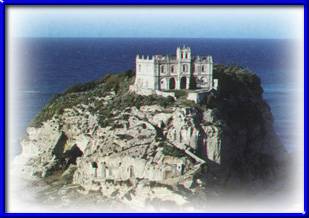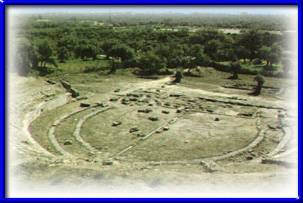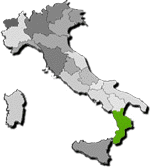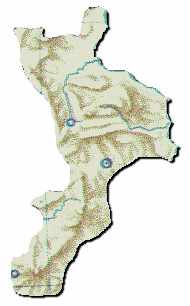Origin of the name:
The territory of Calabria, was inhabitied anciently by the
Bruzis, subsequently it was occupied by the Greeks that called it Betias. Later, the
Romans directed them to transform it to Bruttium. The people of Calabria, were situated
instead in the zone of Puglia, in the Peninsula Salentina that was called Calabria. In the
centuries to follow there was a strange change of names. Already by the time of Charles
Magno the ancient zone of the Bruzio was called Calabria.
| Reliefs - Passes - Coasts - Islands: |
| The reliefs of Calabria are
constituted by the Pollino Mountains, from Wandering Mountains that finish
Appennino Lucano, from Appennino Calabro and from the Coastal Chain that extends
along the western coastal band. In the central part there is the Group of Sila. Sila is
the widest mountainous zone of the Region and offers a beautiful panorama. The tallest top
is Mountain Donato which is 2000 ms. tall. It has three distinguished
parts: Sila Grande in the center, Sila Greca to north and Sila Piccola to the
south. Sila is a zone very rich in water and vegetation. Between the mountainous
part and the coast are some hills wich rise interrupting the level zones, the most
important is: Plain of Sibari on the ionic coast and Plain of S. Eufemia and of Joy
Tauro on the Tyrrhenian. . |

Church of S. Maria of the island in Tropea
|
The coasts are tall and steep in the slope tirrenico, while
they are low and sandy on the ionic slope. Between the regions of the southern peninsula,
Calabria is the one with the biggest coastal development. On the Ionian Sea the
gulves in Taranto and the Gulf of Squillace are opened, while in the part Tirrenicas those
of Sant'Eufemia and of Joy can be found.
Landscape:
The Calabrian territory is predominantly mountainous
and hilly. The landscape is mixed between the continuous mountainous and hilly parts that
go down almost above the sea, leaving some level lines in the zones where the rivers flow.
Two furrows divide the Calabrian peninsula in three rich mountainous groups of green
woods, pastures and spring waters. The conformation of the ground isolates the urban
centers where the population is centralized. In the coastal shores there are no harbors.
Agriculture - Stock-Farm -
Fishing:
Agricultural activity involves the greatest part of the
inhabitants of Calabria, even if it is limited only in the level spaces. Along the coasts
profitable crops are developed such as sugar beets, tobacco, flowers, vegetables, ulivi
and oranges. The typical crop of this region is cedar and the bergamotto which is exported
all over the world. Also abundant it is the cultivation of fig trees and almond trees. The
hilly zones are cultivated to grapevines. The pastorization is in decline, while the
breeding of cattle is flourishing. Although Calabria is surrounded by the sea, fishing is
not very developed. Typical is the fishing of the pescespada in the zones next to the
Narrow of Messina, Bagnara Calabra and Scilla.
Industry - Tourism:
The only industrial zone of relief is that of Crotone,
the rest the inhabitants have been built in recent times plants for the
workmanship of zinc and lead and factories of chemical fertilizers and sour solforico.
Other industrial fittings are tied to the local agricultural productions. The
craftsmanship produces carved woods, carpets and ceramics, but generally fabrics done by
hand. Above all, the tourism is mostly in the of mountainous zones and the coasts.
Position and Frontier:
Calabria is the most southern region of the Italian
peninsula. Joined to north with the Basilicata, it is contended with its two slopes from
the Ionian Sea to east and the Tyrrhenian Sea to west.
| Rivers - Lakes: |

The rests of the Greek Theater of Locri
|
The rivers are of torrential
character and their courses are brief because the mountains are next to the coast.
During the winter and especially in spring, they cause the breakup of snow and an
abundance of water, the rivers go down very violently, overflowing and batheing the
fertile earth. During the summer the greatest part of the rivers are dry. The most
important rivers are Crati with the tributaries Coscile and Muscone and Neto with
the tributary Vitravo. The two rivers are born from Sila and they flow in the Ionian Sea,
while others of less importance are Savuto and Massina that flow in Tyrrhenian. Calabria
is deprived of natural lakes. |
With the varied constructions of channels and dikes, there
are three fully formed artificle big basins fed from the water ways of Sila, between which
lie the Lake Arvo, the Lake of Cacita and the Lake Ampollino.
Climate:
Thanks to the influence of the sea the climate of this
Region is predominantly Mediterranean, while to the inside, in the mountainous zones, the
climate is more rigid with abundant precipitations.
Population:
Calabria lacks big inhabited centers. The causes are
attributed in a large part to the conformity of the ground that is mountainous and from
the agricultural activities of the inhabitants, which are concentrated in isolated areas
from each other. As in almost all the southern countries, also in Calabria there is the
phenomenon of emigration, either abroad or to other italian regions.
Communication:
The Region, is crossed by two railway lines: one along
the whole shore of the coast of tirrenica connects Reggio Calabria to Naples, while the
other deriving from Taranto crosses the Ionic bank. A net inside colleague connects the
most external places to the centers. The last line of highway of the Sunends at
Reggio Calabria passing Villa St. Giovanni. The connection to Sicily in the Narrow of
Messina happens from medium a net of ferry-boats.
Web Site designed by MediaSoft - © Copyright 1998-1999
- All rights reserved






